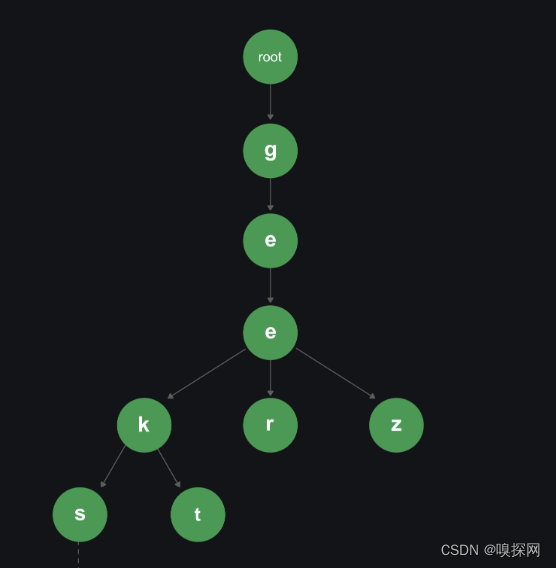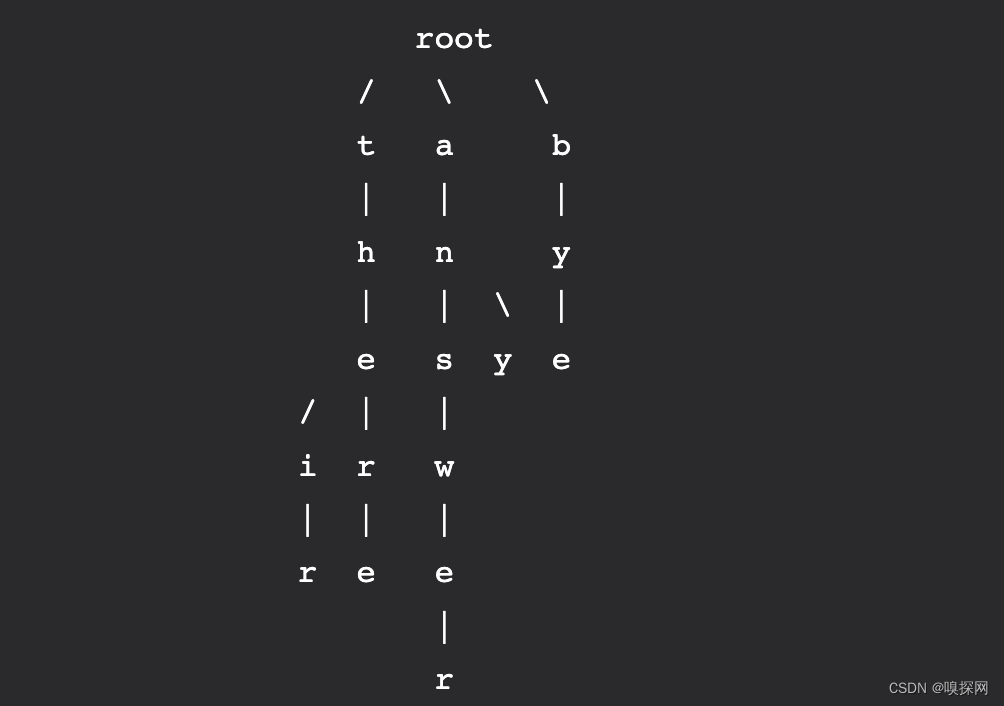Trie即字典树是一种高效的信息检索数据结构。使用 Trie,搜索时间复杂性可以达到最佳(Key的长度)。如果我们将Key存储在二叉搜索树中,平衡良好的 BST 的各种操作的时间复杂度与M * log N成正比,其中 M 是最大字符串长度,N 是树中Key的数量。使用 Trie,我们可以在 O(M) 时间内搜索到Key,但是,Trie 的缺点是对存储要求很高即空间复杂度较高。
Trie 的每个节点都由多个分支组成。每个分支代表一个可能的键。我们需要将每个键的最后一个节点标记为词节点的结尾。Trie 节点字段isEndOfWord用于将节点区分为词节点的结尾。表示英文字母节点的简单结构如下,
/ Trie node
struct TrieNode
{
struct TrieNode *children[ALPHABET_SIZE];
// 如果节点
// 表示单词的结尾, 则 isEndOfWord 为真
bool isEndOfWord;
};
简单的Trie结构

将单词插入 Trie 的方法很简单。单词的每个字母都作为一个单独的 Trie 节点插入。请注意,children即Trie节点的子节点是指向下一级 trie 节点的指针(或引用)数组。单词的字母充当数组children的索引。如果插入的单词是新的或者是现有词的扩展,我们需要构造新的节点。如果新插入的词是Trie中现有词的前缀,我们只需将这个词的最后一个字母标记为该词的结尾。词的长度决定了 Trie 深度。
搜索操作类似于插入操作,但是我们只比较字符串中的元素并向下移动。由于isEndOfWord为true或 trie 中缺少指向下一层的子节点,则搜索终止。如果最后一个节点的isEndofWord字段为true,则该键存在于 trie 中。在第二种情况下,搜索被迫终于并未完整遍历字符串,因为字符串不存在于 trie 中。
图解

代码实现
class TrieNode:
# Trie node class
def __init__(self):
self.children = [None]*26
# isEndOfWord is True if node represent the end of the word
self.isEndOfWord = False
class Trie:
# Trie data structure class
def __init__(self):
self.root = self.getNode()
def getNode(self):
# Returns new trie node (initialized to NULLs)
return TrieNode()
def _charToIndex(self,ch):
# private helper function
# Converts key current character into index
# use only 'a' through 'z' and lower case
return ord(ch)-ord('a')
def insert(self,key):
# If not present, inserts key into trie
# If the key is prefix of trie node,
# just marks leaf node
pCrawl = self.root
length = len(key)
for level in range(length):
index = self._charToIndex(key[level])
# if current character is not present
if not pCrawl.children[index]:
pCrawl.children[index] = self.getNode()
pCrawl = pCrawl.children[index]
# mark last node as leaf
pCrawl.isEndOfWord = True
def search(self, key):
# Search key in the trie
# Returns true if key presents
# in trie, else false
pCrawl = self.root
length = len(key)
for level in range(length):
index = self._charToIndex(key[level])
if not pCrawl.children[index]:
return False
pCrawl = pCrawl.children[index]
return pCrawl.isEndOfWord
# driver function
def main():
# Input keys (use only 'a' through 'z' and lower case)
keys = ["the","a","there","anaswe","any",
"by","their"]
output = ["Not present in trie",
"Present in trie"]
# Trie object
t = Trie()
# Construct trie
for key in keys:
t.insert(key)
# Search for different keys
print("{} ---- {}".format("the",output[t.search("the")]))
print("{} ---- {}".format("these",output[t.search("these")]))
print("{} ---- {}".format("their",output[t.search("their")]))
print("{} ---- {}".format("thaw",output[t.search("thaw")]))
if __name__ == '__main__':
main()
Trie的优点
- 使用 Trie,我们可以在O(L)时间内插入和查找字符串,其中L表示单个字符串的长度。这显然比 BST 更快。由于它的实现方式,这也比哈希表更快。我们不需要计算任何哈希函数。不需要冲突处理
- Trie 的另一个优点是,我们可以简单的实现按字母顺序打印字符串,这在哈希表中是不容易做到的。
- Trie允许我们快速的进行前缀搜索
其他语言实现下载链接:
(包含各种语言:C、Python、Java、C++、C#、Javascript等均有示例)
免费资源下载:Trie







 本文详细介绍了字典树(Trie)的数据结构及其应用。Trie是一种用于高效信息检索的数据结构,能够以O(L)时间复杂度完成字符串的插入和查找,其中L为字符串长度。文章解释了Trie的基本概念、节点结构、插入和搜索操作,并对比了Trie与二叉搜索树和哈希表的不同之处。
本文详细介绍了字典树(Trie)的数据结构及其应用。Trie是一种用于高效信息检索的数据结构,能够以O(L)时间复杂度完成字符串的插入和查找,其中L为字符串长度。文章解释了Trie的基本概念、节点结构、插入和搜索操作,并对比了Trie与二叉搜索树和哈希表的不同之处。

















 346
346

 被折叠的 条评论
为什么被折叠?
被折叠的 条评论
为什么被折叠?








